Kat Barefield, MS, RD, CPT
In this post, you’re going to learn about the different
things that happen in the body as a result of not consuming adequate amounts of micronutrients
on a regular basis.
This article will also cover:
- The key functions of various micronutrients
- The most common under-consumed micronutrients in the U.S.
- Food sources that are rich in vitamins and minerals
- How weight loss and popular diets effect the amounts of micronutrients you get
If any of these topics interest you, keep reading.
Overview of Metabolism
“Metabolism” is a commonly used term by trainers and fitness
enthusiasts alike. Have you ever stopped to think what it really is? This may
help:
(Click image to view larger map)
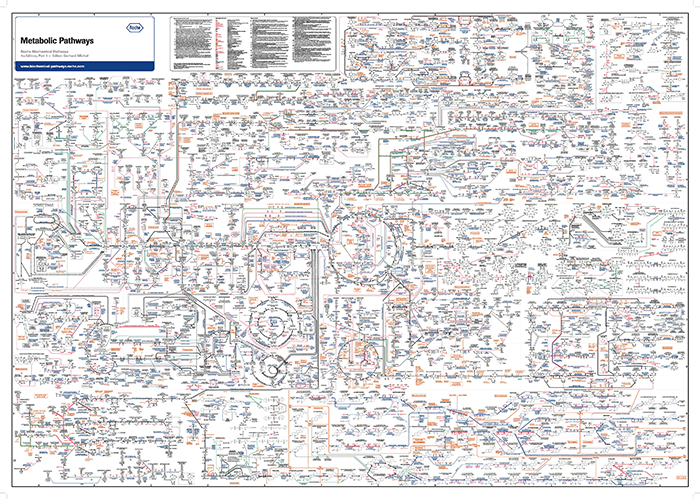
The drawing depicts the countless reactions that occur continuously
to keep you alive with little to no effort on your behalf. Breathing, thinking,
your heart beating, digestion, circulation, movement and so on. Amazing right?
So, what does it take to keep all these reactions going?
Nutrients (and oxygen).
There are six classes of nutrients that are essential for
human health, meaning we can’t live without them without negatively impacting
our health and our bodies don’t make them. Therefore, we must obtain them from
our diet. They are as follows:
- Carbohydrates
- Protein
- Fats
- Vitamins
- Minerals
- Water
Carbohydrates, protein, and fats are collectively named
macronutrients because we need them in large quantities. They provide calories,
or energy in the form of ATP to run all metabolic reactions, which are jumpstarted
by proteins called enzymes. Enzymes need cofactors to work, and that is where vitamins
and minerals, referred to as micronutrients, come in. We need these in smaller
quantities. Listed below are some examples.
Key Functions of Selected Micronutrients:
- B vitamins are needed to extract energy (calories) from food
- Vitamin B12 is required for proper nerve function and to make red blood cells
- Vitamin A is needed for good vision, immunity, and healthy skin
- Vitamin D is required to form bone and strong immune function. It is involved in numerous reactions throughout the body,
functioning as a hormone
- Vitamin E is an antioxidant and helps protect cells from damage
- Vitamin K is needed to form blood clots and to shuttle calcium into bone
- Calcium is needed for muscle contraction and bone formation
- Iron is required to transport oxygen throughout the body
- Magnesium regulates muscle contraction and nerve transmission. It helps form teeth and bones and is needed in over 300 metabolic reactions.
- Potassium is needed for muscle contraction, proper nerve conduction and maintenance of fluid and electrolyte balance
There are approximately 30 vitamins and minerals we need to consume regularly. Each one has multiple functions and work synergistically to run your metabolism to keep you alive and healthy.
The image below shows the various food sources of micronutrients.
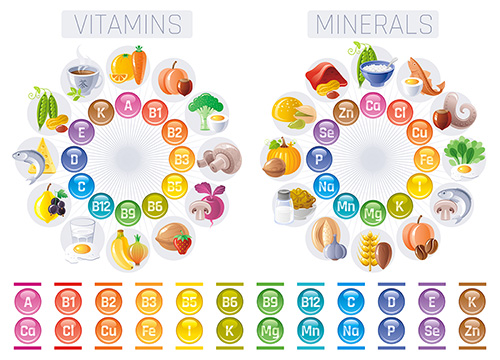
How Much do You Need?
Scientists at the Institute of Medicine have established
amounts of micronutrients to consume daily, referred to as RDAs (Recommended
Dietary Allowances) based on age, gender, and life stage. It is important to
note that these recommended values aim to prevent deficiencies and their related
diseases and conditions and are not necessarily optimal for longevity.
This table contains the daily recommend amounts for certain
micronutrients. Remember there’s about 30 of them. You can get the full list of
recommended amounts of minerals here and vitamins here.
| |
Vitamin A (mcg/d)
|
Vitamin C
(mg/d)
|
Vitamin D
(IU/d)
|
Vitamin E
(mg/d)
|
Vitamin K
(mcg/d)
|
Folate
(mcg/d)
|
|
Males
|
|
|
|
|
|
|
|
14-18 y
|
900
|
75
|
600
|
15
|
75
|
400
|
|
19-30 y
|
900
|
90
|
600
|
15
|
120
|
400
|
|
31-50 y
|
900
|
90
|
600
|
15
|
120
|
400
|
|
51-70 y
|
900
|
90
|
600
|
15
|
120
|
400
|
|
>70 y
|
900
|
90
|
800
|
15
|
120
|
400
|
|
Females
|
|
|
|
|
|
|
|
14-18 y
|
700
|
65
|
600
|
15
|
75
|
400
|
|
19-30 y
|
700
|
75
|
600
|
15
|
90
|
400
|
|
31-50 y
|
700
|
75
|
600
|
15
|
90
|
400
|
|
51-70 y
|
700
|
75
|
600
|
15
|
90
|
400
|
|
>70 y
|
700
|
75
|
800
|
15
|
90
|
400
|
|
Pregnancy
|
|
|
|
|
|
|
|
19-50 y
|
770
|
85
|
600
|
15
|
90
|
600
|
|
Breastfeeding
|
|
|
|
|
|
|
|
19-50 y
|
1,300
|
120
|
600
|
19
|
90
|
500
|
| |
B6
(mg)
|
B12
(mcg)
|
Choline
(mg)
|
Calcium
(mg)
|
Magnesium
(mg)
|
Potassium [1]
(mg)
|
Iron
(mg)
|
|
Males
|
|
|
|
|
|
|
|
|
14-18 y
|
1.3
|
2.4
|
550
|
1,300
|
410
|
3,000
|
11
|
|
19-30 y
|
1.3
|
2.4
|
550
|
1,000
|
400
|
3,400
|
8
|
|
31-50 y
|
1.3
|
2.4
|
550
|
1,000
|
420
|
3,400
|
8
|
|
51-70 y
|
1.7
|
2.4*
|
550
|
1,000
|
420
|
3,400
|
8
|
|
>70 y
|
1.7
|
2.4*
|
550
|
1,200
|
420
|
3,400
|
8
|
|
Females
|
|
|
|
|
|
|
|
|
14-18 y
|
1.2
|
2.4
|
400
|
1,300
|
360
|
2,300
|
15
|
|
19-30 y
|
1.3
|
2.4
|
425
|
1,000
|
310
|
2,600
|
18
|
|
31-50 y
|
1.3
|
2.4
|
425
|
1,000
|
320
|
2,600
|
18
|
|
51-70 y
|
1.5
|
2.4*
|
425
|
1,200
|
320
|
2,600
|
8
|
|
>70 y
|
1.5
|
2.4*
|
425
|
1,200
|
320
|
2,600
|
8
|
|
Pregnancy
|
|
|
|
|
|
|
|
|
19-50 y
|
1.9
|
2.6
|
450
|
1,000
|
350-360
|
2,900
|
27
|
|
Breastfeeding
|
|
|
|
|
|
|
|
|
19-50 y
|
2.0
|
2.8
|
550
|
1,000
|
310-320
|
2,800
|
9
|
|
|
|
|
|
|
|
|
|
|
|
|
|
*Should be in fortified foods or supplemental free form due to age-related
food-bound malabsorption
As a registered dietitian, my advice is to eat a wide
variety of colorful and minimally processed foods from all major food groups to
maximize your nutrient intake, while staying within your calorie needs to
either maintain a healthy body weight or achieve one.
Here’s what a micronutrient rich diet looks like for someone who needs
2,200 calories per day:
- 3 cups of vegetables a day, distributed as follows:
- 2 cups per week of dark-green vegetables
- 6 cups per week of red and orange vegetables
- 2 cups per week of legumes (beans and peas)
- 6 cups per week of starchy veggies (potatoes, green peas, corn, plantains)
- 5 cups per week of other veggies (iceberg lettuce, mushrooms, onions, cabbage)
- 2 cups a day of fruit
- 3 ½ ounces of whole grains (whole wheat bread,brown rice, oatmeal, quinoa)
- 3 ½ ounces of other refined enriched grains (white rice, refined grain cereals, pasta)
- 3 cups of dairy
- 6 ounces of protein broken down as follows:
- 9 ounces per week of seafood
- 28 ounces per week of meats, poultry, eggs
- 5 ounces per week of nuts, seeds, soy
- 29 grams of oils
How do you suppose Americans measure up to the
recommendations above for getting sufficient vitamins and minerals?
Here’s a snapshot from the U.S.D.A. and the Dietary
Guidelines for Americans which revealed the percentage of people who fall short
of the listed vitamins and minerals:

Put another way, the top six sources of calories in the U.S diet
identified by the Dietary Guidelines Committee include:
- Desserts (grain based, i.e. cakes, cookies,
donuts, etc.
- Bread
- Chicken and chicken mixed dishes
- Soda
- Pizza
- Alcoholic beverages+
It’s safe to say that most Americans are not eating a
micronutrient rich diet. In the United
States and other developed countries, overt deficiencies and their related
diseases are rare. However, insufficiencies, or intakes below the RDAs are
common. The 2015-2020 Dietary Guidelines for Americans report identified 9
nutrients that are widely under consumed. These include:
- Calcium
- Magnesium
- Potassium
- Vitamin D
- Vitamin A
- Vitamin C
- Vitamin E
- Choline
- Fiber
So, What Happens When You Don’t Get Enough
Micronutrients?
Since vitamins and minerals are required for numerous physiological
processes in the body, chronic shortages will negatively impact various aspects
of health and metabolism. There is evidence that micronutrient insufficiencies are
linked to a variety of age-related chronic disease including cancer,
osteoporosis, and heart disease. [3] [4] [5]
Folate and the Birth of the Prenatal Vitamin (pun intended)
Folate (vitamin B9) is naturally present in legumes and
leafy greens. It is required for the synthesis of DNA and supports cell growth
and repair. Insufficient folate in the
body is linked to neural tube defects and there’s evidence for its role in
preventing strokes. [6]
The bioavailability of folate in food is limited, meaning
the body isn’t able to extract it and use it, whereas the synthetic form, folic
acid has much greater stability and bioavailability and is more effective at raising
the body’s stores. Multivitamin and mineral formulas with folic acid have proven
to decrease neural tube defects and the prenatal vitamin is currently a
worldwide recommendation during pregnancy and for women of childbearing age. [7]
In 1998, folic acid was added to the U.S. food supply
through fortification of refined grain products, and the prevalence of newborns
with neural tube defects has dropped. Whether you realize or not, you’ve been
supplementing your diet for quite some time.
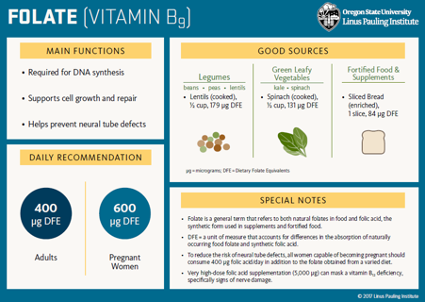
Calcium and Bone Building Micronutrients
Let’s take a look at calcium. Most Americans do not reach
the daily recommended amounts of bone building nutrients calcium, magnesium, vitamin
K, and vitamin D due to poor food choices, food preferences, access, and other
factors. In the case of calcium, 99% is stored in the skeletal structure and 1%
is tightly maintained in the blood at 8.4 to 9.5 mg/dL to keep essential
functions running so that you stay alive, reproduce and propagate the species.
When you don't consume adequate amounts of calcium, the body
will breakdown bone to maintain blood levels to keep your heart beating. Over time,
chronic shortages of calcium and synergistic nutrients lead to weakened bones
and eventually osteoporosis.
You survive in the short term at the expense of long-term
health.
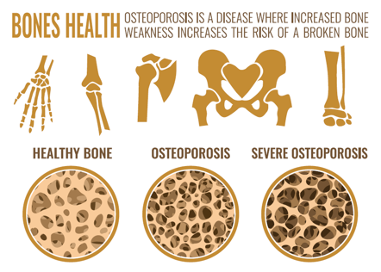
Insufficient amounts of micronutrients lead to undetectable
damage which can speed up age-related disease. And because people don’t see or
feel the damage occurring, they don’t realize there’s a problem until it’s too
late.
For example, in Vitamin K, the
clotting proteins get it first... and
only after they're satisfied do you prevent calcification of the arteries, or
prevent cancer, or prevent bone fractures. It's all insidious damage that you
get that's a long-term consequence. In fact, we call these the diseases of
aging. – Bruce Ames
How Multivitamins and Other Supplements Can Help
Take a moment to answer the following questions:
- Do you have medical insurance?
- Do you have dental insurance?
- Do you have car insurance?
- Do you have renters or mortgage insurance?
- What about life insurance?
- And pet insurance?
- Why do you have all these types of insurances?
- Now, do you have nutritional insurance?
Nutritional insurance, in the form of a low dose multivitamin and mineral containing a broad range of under consumed micronutrients and is suitable for
your age, gender, life stage and activity level covers your vitamin and mineral
needs “just in case” you aren’t getting them all from food on a daily basis. [8] As discussed, most don’t get everything they need from food alone.
A properly
made multivitamin certainly doesn’t replace a well-rounded diet, but rather
complements your food intake to insure
you’re getting the micronutrients you need.

Supplements everyone should take if they don’t consume
enough due to dietary preferences, access, climate, allergies, etc. include calcium, iron, vitamin D or omega-3 fish oils. Doing so would help reach recommended
levels and would also serve as nutritional insurance.
Survey data consistently shows that people who use
supplements have fewer micronutrient insufficiencies and/or higher
micronutrient intakes. For instance, compared to food alone, taking a
multivitamin and mineral was associated with a lower prevalence of inadequacies
for 15 of 17 micronutrients examined. [9]
Another study showed that multivitamin and mineral supplements
significantly reduced the prevalence of insufficient intakes of calcium,
magnesium, vitamins A, C, D and E. [10]
Similar findings in other countries have been published.
The Impact of Weight Loss Diets on Micronutrient Intakes
For those attempting weight loss or are avoiding one or more
food groups as is the case with vegan or vegetarian diets, Paleo diets, gluten
free diets, and ketogenic diets, nutritional insurance is even more important since
you’re eliminating micronutrients which are contained in the foods you’re
avoiding.

A study analyzing four popular diet plans including Atkins
for Life, the Best Life diet, The South Beach Diet, and the DASH diet, found
that each one failed to provide sufficient amounts of several essential
micronutrients. [11]
- The South Beach diet was deficient in 21
micronutrients (modified low carb)
- The Atkins for Life diet was deficient in 15
micronutrients (low carb)
- The DASH diet was deficient in 13 micronutrients
and (low fat)
- The Best Life diet was deficient in 12
micronutrients. (Oprah endorsed)
Another study looked at three popular diets which included a
vegan weight loss diet, a low carb/high protein weight loss diet and a whole
food, plant-based diet for weight maintenance. Seven menu plans from each diet
were analyzed for 20 different micronutrients and compared them to the RDAs for
adult males. [12]
- The Eat to Live vegan diet for aggressive weight
loss diet restricts you from eating dairy, refined grains, sugars and oils and limits
starchy veggies, dried fruits, grains, nuts, and seeds.
- The Fast Metabolism Diet, which is low in carbs
and high in animal protein limits wheat, corn, dairy, soy, dried fruit, fruit
juices, refined sugar, alcohol, artificial sweeteners, and “diet” foods.
- The Eat, Drink and Be Healthy Diet for weight
maintenance limits red meat, potatoes, refined grains, soft drinks, candies, desserts,
and saturated fats.
Here’s what the study
revealed:
- The Eat to Live vegan diet failed to provide sufficient
amounts of seven micronutrients including B3, B12, vitamin D, vitamin E,
calcium, selenium, and zinc
- The Fast Metabolism low carb diet failed to
provide six micronutrients including B1, vitamin D, vitamin E, calcium, magnesium,
and potassium
- The Eat Drink and Be Healthy Diet failed to
provide three micronutrients including vitamin D, calcium, and potassium.
It’s risky and counterproductive to follow a weight loss
diet to improve your health while simultaneously increasing the risk for chronic
diseases. If you’re following a weight
loss diet, be sure to get the nutrients you’re missing to support your health
and longevity. The table below includes some common popular diets.
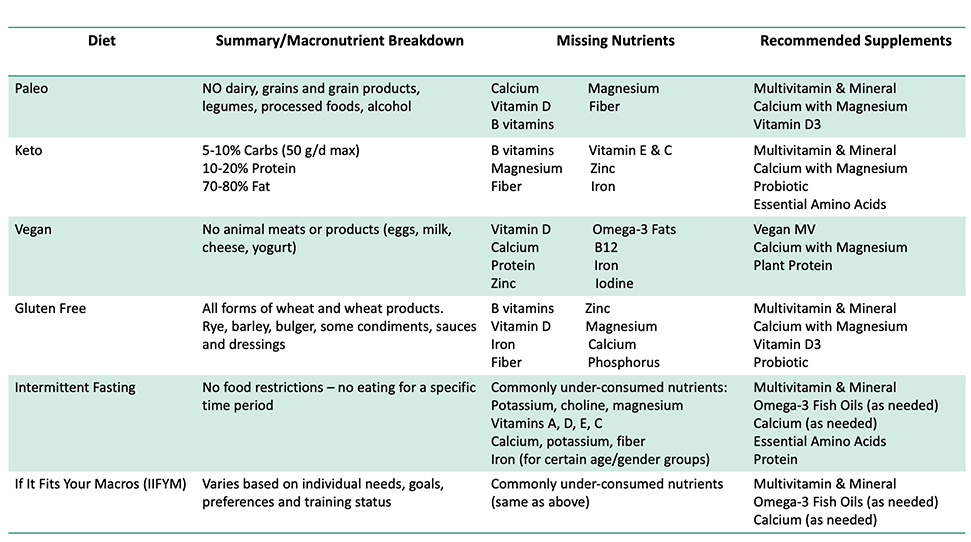
Summary
The human body is programmed for survival and has
sophisticated mechanisms for addressing chronic shortages of micronutrients by
rationing their use for proteins and functions that are essential to keep you
alive, while sacrificing vitamin/mineral dependent proteins that are critical
for long-term health.
Therefore, meeting daily recommended amounts of the ~30
micronutrients is equally important as hitting your daily macros.
To maximize your micronutrient intake, you will need to
consistently eat a variety of food sources from all the major food groups. Dieting
for weight loss, avoiding entire food groups, or eating the same foods with
little variety limits your micronutrient intake and leads to greater vitamin
and mineral insufficiencies.
Despite a plethora of healthy eating guidelines, the data clearly and repeatedly shows that
most Americans fall short of several key micronutrients, setting themselves up
for chronic disease and other health issues. Keep in mind, that overweight and obese
individuals, which makes up approximately 70% of the U.S adult population, tend
to consume obesogenic diets which are high in calories and low in
micronutrients, and the obese have the highest rates of chronic disease.
Using a low dose multivitamin and mineral has proven to help
raise intakes to the recommended amounts needed to support physiological
functions to meet the immediate demands of the body while supporting long-term
health.
Nothing replaces a good diet along with other healthy
behaviors such as adequate sleep, regular exercise, managing stress and
maintaining a healthy body weight. In the case of micronutrients, a little
insurance goes a long way.
Use this tool to see which mulvitamin is right for you.
References
[1] National Academies of Sciences, Engineering, and Medicine. 2019. Dietary Reference Intakes for Sodium and
Potassium. Washington, DC: The National Academies Press. https://doi.org/10.17226/25353.
[2] Dietary
Guidelines for Americans 2015-2020. 8th ed. Washing, DC: U.S.
Department of Health and Human Services; U.S. Department of Agriculture, 2015.
[3] Ames BN.
Prolonging healthy aging: Longevity vitamins and proteins. Proceedings of the
National Academy of Sciences Oct 2018, 115 (43) 10836-10844; DOI:
10.1073/pnas.1809045115
[4] McCann
JC, Ames BN. Vitamin K, an example of triage theory: is micronutrient
inadequacy linked to diseases of aging?. Am J Clin Nutr. 2009;90(4):889-907.
doi:10.3945/ajcn.2009.27930. PMID: 19692494
[5] McCann
JC, Ames BN. Adaptive dysfunction of selenoproteins from the perspective of the
triage theory: why modest selenium deficiency may increase risk of diseases of
aging. FASEB J. 2011;25(6):1793-1814. doi:10.1096/fj.11-180885. PMID: 21402715
[6] McNulty
H, Pentieva K, Hoey L, Strain J, Ward M. Nutrition throughout life: folate. Int
J Vitam Nutr Res. 2012;82(5):348-354. doi:10.1024/0300-9831/a000130. PMID: 23798054
[7] Czeizel
AE, Dudás I. Prevention of the first occurrence of neural-tube defects by
periconceptional vitamin supplementation. N Engl J Med.
1992;327(26):1832-1835. doi:10.1056/NEJM199212243272602. PMID: 1307234
[8] Blumberg
JB, Cena H, Barr SI, et al. The Use of Multivitamin/Multimineral Supplements: A
Modified Delphi Consensus Panel Report. Clin Ther. 2018;40(4):640-657.
doi:10.1016/j.clinthera.2018.02.014. PMID: 29573851
[9] Blumberg
JB, Frei BB, Fulgoni VL, Weaver CM, Zeisel SH. Impact of Frequency of
Multi-Vitamin/Multi-Mineral Supplement Intake on Nutritional Adequacy and
Nutrient Deficiencies in U.S. Adults. Nutrients. 2017;9(8):849.
Published 2017 Aug 9. doi:10.3390/nu9080849. PMID: 28792457
[10] Wallace
TC, McBurney M, Fulgoni VL 3rd. Multivitamin/mineral supplement contribution to
micronutrient intakes in the United States, 2007-2010. J Am Coll Nutr.
2014;33(2):94-102. doi:10.1080/07315724.2013.846806. PMID: 24724766
[11] Calton
JB. Prevalence of Micronutrient Deficiency in Popular Diet Plans. JISSN. 7:24,
2010. PMID: 20537171
[12] G
Engel M, J Kern H, Brenna JT, H Mitmesser S. Micronutrient Gaps in Three
Commercial Weight-Loss Diet Plans. Nutrients. 2018;10(1):108. Published
2018 Jan 20. doi:10.3390/nu10010108. PMID: 29361684